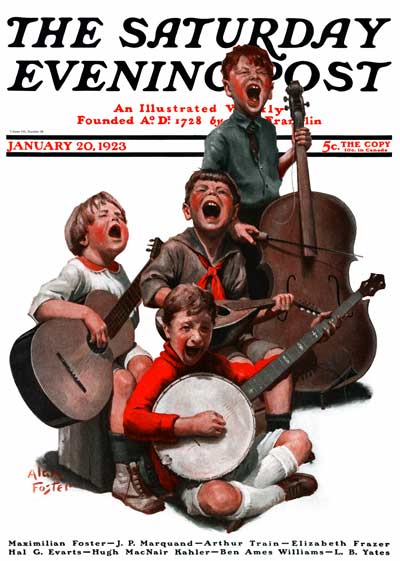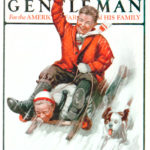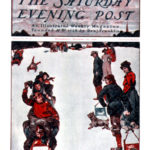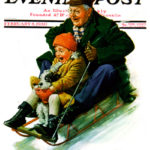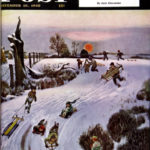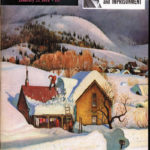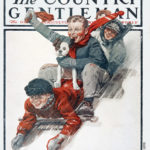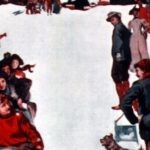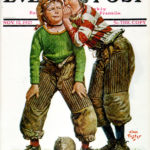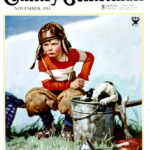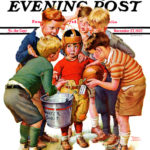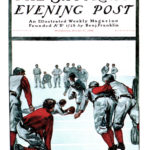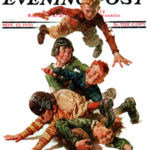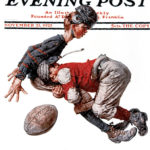Classic Covers: Gridiron Grit
America is in love with football, and if these Post covers are indication, they always have been. Glimpse into the hilarity and heartbreak of life on (and off) the field.

Alan Foster
November 12, 1927
Not much is known about illustrator Alan Foster, who created more than 30 covers for the Post. His narrative style is reminiscent of Norman Rockwell’s, and his paintings often capture the silly and joyful moments in life.
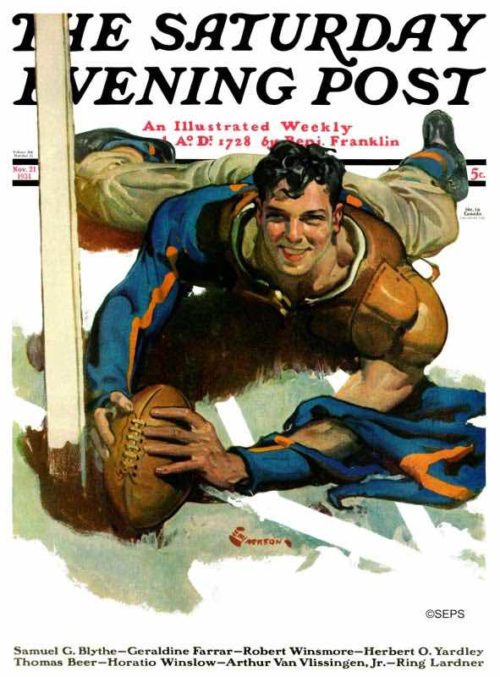
E. M. Jackson
November 21, 1931
An artistic specialty of E.M. Jackson’s was painting women in poses that made them appear seductive and glamorous amidst architecturally authentic backgrounds. Usually, he illustrated for manuscripts involving romance and high society. However, he also illustrated for a wide variety of genres, including murder mystery and (as illustrated in this cover) masculine adventure.
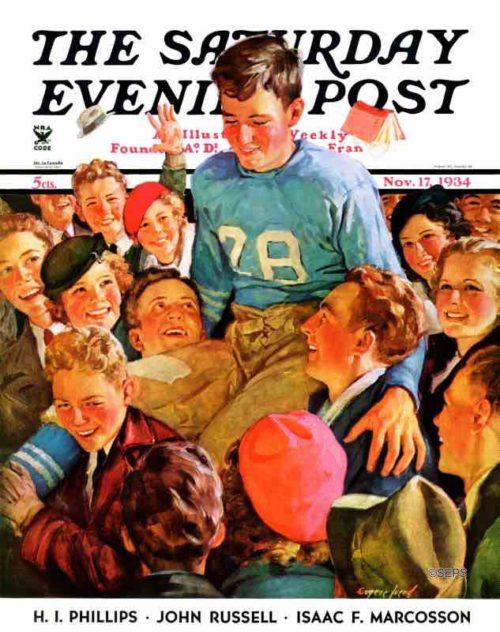
Eugene Iverd
November 17, 1934
Eugene Iverd lived in Erie, Pennsylvania, where he often used children there as his models. Iverd produced 30 covers for The Saturday Evening Post between 1926 and 1936.

Lonie Bee
October 22, 1938
Lonie Bee illustrated 6 covers for the Post, all focused on sports, and most depicting a moment of consternation, whether it was cheerleaders mourning a losing game or a football player trying to sway the ref.
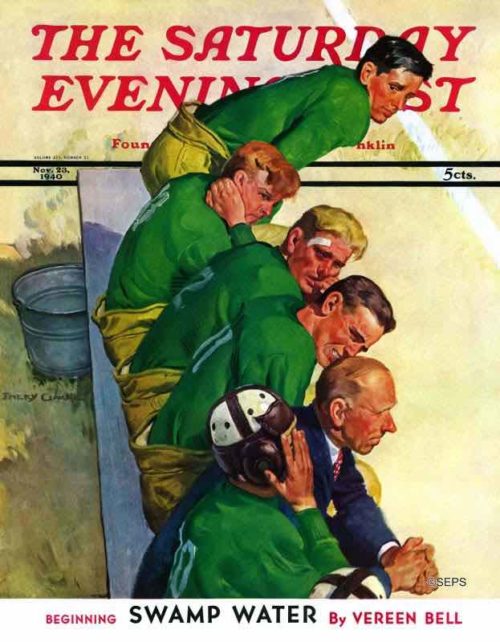
Emery Clarke
November 23, 1940
Emery Clarke was an illustrator of magazine and pulp novel covers, one of the most well-known being the Doc Savage series. He also collaborated with Russell Stamm on the comic strip, The Invisible Scarlet O’Neal.
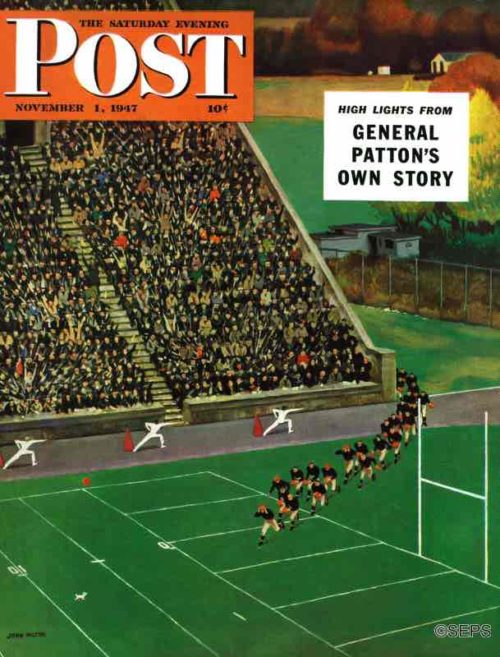
John Falter
November 1, 1947
It seems to John Falter that one of the best moments in football is that curtain-going-up moment when the squads trot out on the field. For one thing, the team in which your hopes are invested always looks pretty good at that stage; even an outfit that is going to take a terrific lacing when the whistle blows can look like champions executing this maneuver. The politic artist said the squad might be that of any school whose colors are orange and black. That takes in a fine range of educational institutions and makes it almost impossible that Falter should have picked a loser. He chose the Princeton stadium for background, and Falter Hypothetical Institute, taking the field, seems to be based on Princeton, without the Tigers’ stripes. (Reprinted from the November 1, 1947 Post)
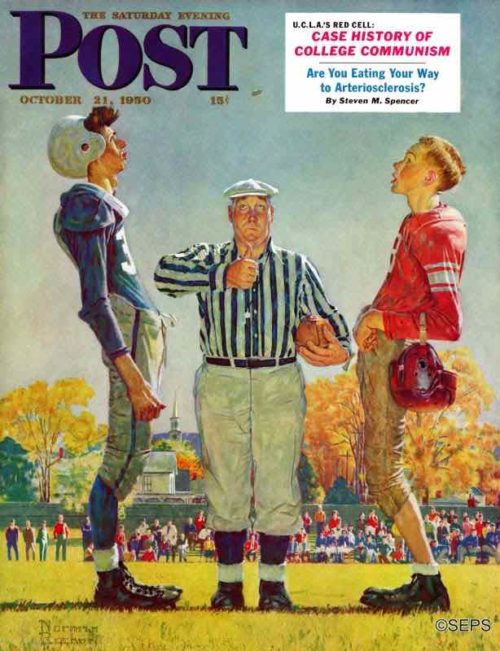
Norman Rockwell
October 21, 1950
With baseball temporarily out of their systems, sport lovers now are concentrating on the gridiron in their constant search for nervous tension. The spotlights of fame play on the collisions of 200-pound colossi in great stadia. But Norman Rockwell reminds us that the super crises are suffered back-country, where Bill Jones, of Mapleville High, strives for the honor of a town where everybody has known him since he was knee-high to a tackling dummy. If Bill wins the game, he’ll not be just a remote newspaper hero, but the idol of the gals in his algebra class and of the mayor he meets walking down the street. If he loses it, the gals will go home teary-eyed, and so may the mayor. “Heads or tails?” grunts Joe Fate, the referee. (Reprinted from the October 21, 1950 Post)
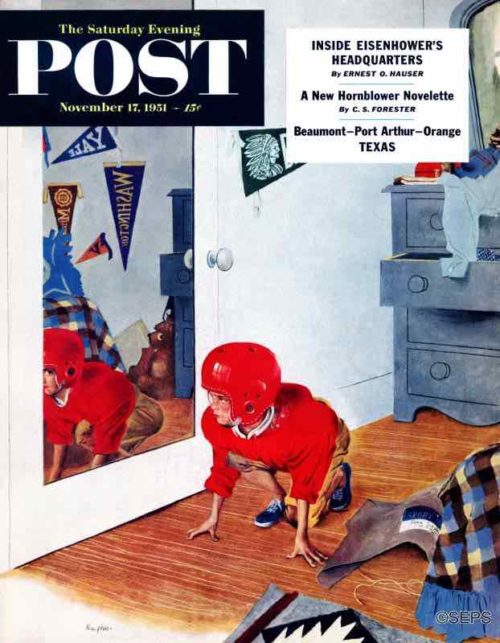
George Hughes
November 17, 1951
This ferocious young grid star, magnified by the terrifying man-from-Mars armor peculiar to football and inflamed by imagination, is about to crunch the enemy’s forward wall, snare a forward pass with his fingertips and weave 70 years down the field for a TD as thousands cheer. Actually, the first play in which he exposes that new uniform to the stark realities of life may see him land on his neck and become a door mat, while some other guy does the crunching. But Artist Hughes says that if this does happen, we can be confident that any lad he would paint will find biting the dust distasteful and will react with such vigor that within a few years he will he offered athletic scholarships to fifteen colleges. (Reprinted from the November 17, 1951 Post)
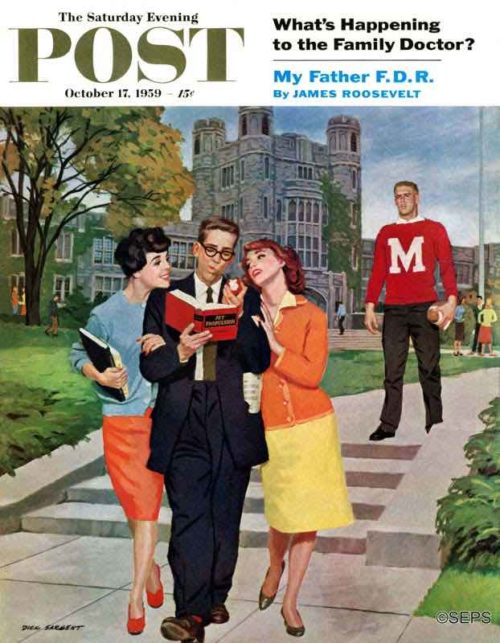
Richard Sargent
October 17, 1959
What strange switch on traditional romance have we here? Those two peaches can’t just be asking for a bite of apple; no, they are applying to a man some seductive apple-polishing with intent to captivate, then capture him. Well, how come that they are chinning themselves on the bony shoulders of H. Arthur Jet and leaving Big M over there looking as if he might break down and cry? Artist Dick Sargent’s theme is that in the fall a young maid’s fancy seriously turns—in these serious days—to thoughts of eventual matrimony, and that H. Arthur is not only a good guy but, being enamored of technology, a potentially good provider. So be it; but let’s not sell Big M short. There is no law against a football star’s becoming another kind of star, too, and lots of them have done so. (Reprinted from the October 17, 1959 Post)
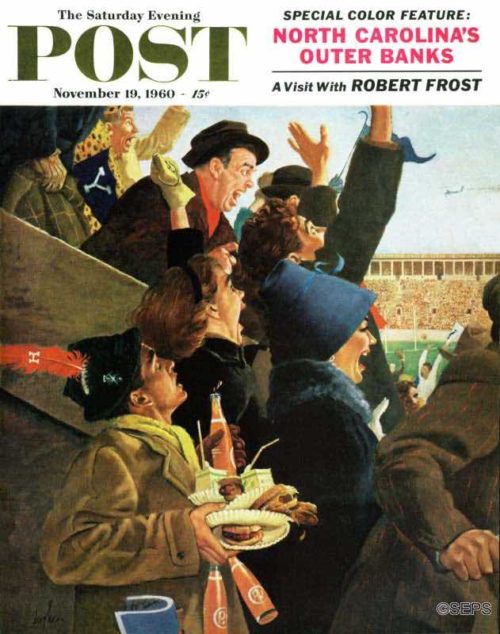
George Hughes
November 19, 1960
The Harvard chap in the foreground is searching for a receiver in the open, but his view is blocked by an exultant pack of Yale Bulldogs. It would seem that while the Crimson was successful at a hot-dog stand, Yale spoiled the attempt at a goalline stand. “Bull-dog! bull-dog! Bow, wow, wow!” shriek the Yale fans, as portrayed by artist George Hughes. (Hughes is neutral. His father-in-law is a Yale graduate, but both his sons-in-law are Harvard.) The Harvard-Yale rivalry commenced in 1875, and Eli Yale has a seventeen-game edge. This week’s combat will be staged at Harvard Stadium — not that the field of battle is likely to affect the outcome. The Bulldogs took a drubbing in 1914, the year the Yale Bowl was dedicated. Yale had the bowl, we read somewhere; Harvard supplied the punch. (Reprinted from the November 19, 1960 Post)
Classic Covers: Alan Foster
"String Quartet"
from January 20, 1923
As with many illustrators of the 1920s and ’30s, we were unable to unearth much information about Alan Foster. But we were able to find some of his irresistible covers!
“Sweet Adeline”
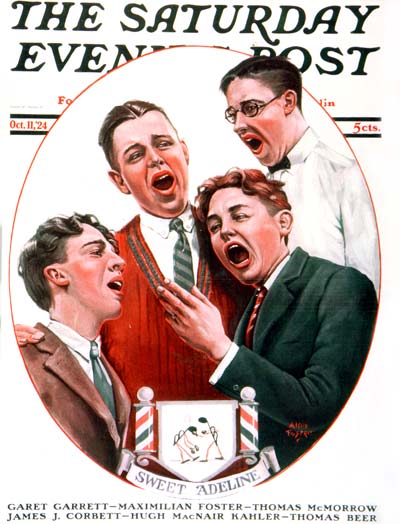
"Sweet Adeline"
from October 11, 1924
“Sweet Adeline” was a barbershop standard by the time of this 1924 cover -– and remains so. The song was written back in 1903, so if this hearty quartet wanted to try something trendier, they could belt out Al Jolson’s “California, Here I Come,” “It Had to be You,” or “Charleston” -– all top songs of 1924. It is intriguing the way the artist captured each face as the singer struck just the right note.
“Faithful Friends”
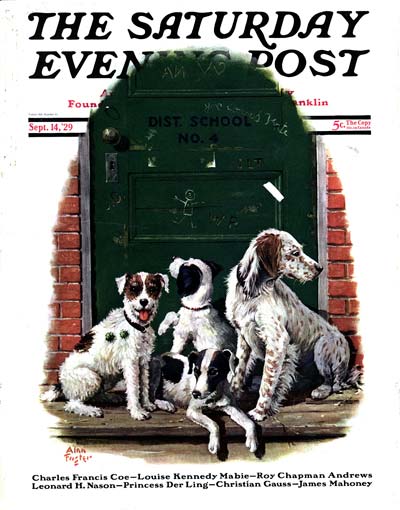
"Faithful Friends"
from September 14, 1929
Outside “Dist. School No. 4” these dogs wait for their best pals. Foster must have grown accustomed to drawing canines: For three years in the 40s he did a cartoon series for Collier’s called “Mr. Fala of the White House.” Fala, of course, was Franklin Roosevelt’s dog and something of a celebrity in his own right. Foster’s cartoons might show the little black terrier traveling with his master or running off with a senator’s hat.
“Traffic Cop”
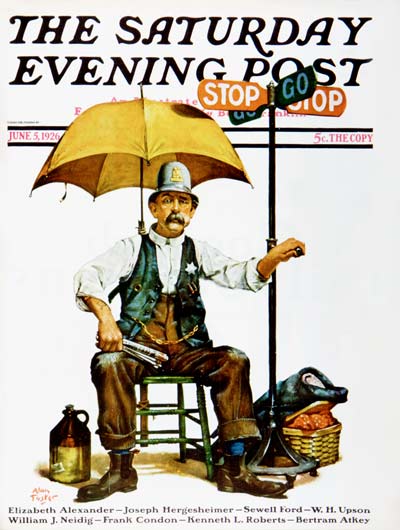
"Traffic Cop"
from June 5, 1926
This 1926 cover shows us a side of commuting we just don’t think much about these days: early traffic signals, manually operated by the local traffic cop. The signal is called a semaphore, and a version of it first appeared in London in 1868. Foster’s traffic official is apparently set for the day, with his lunch and water supply at the ready.
“Hot Tamale 5”
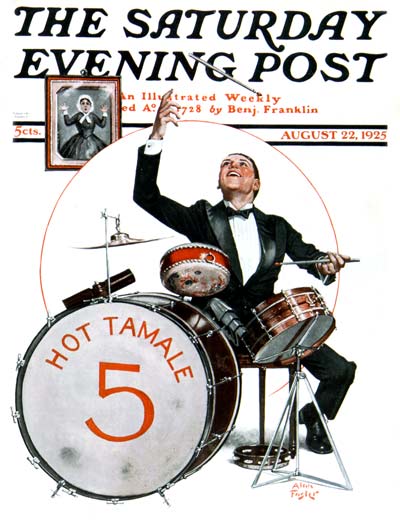
"Hot Tamale 5"
from August 22, 1925
This rockin’ drummer from 1925 is bringing the house down. Grandma would be shocked…actually, even her photo is appalled! Well, it’s to be expected with a band named the “Hot Tamale Five.” The meager biographical information we were able to glean indicates that Foster illustrated for several magazines of the ’20s, including The New Yorker, and, in addition to painting great illustrations and cartooning, even had a brief acting career.
“I Was Tardy”
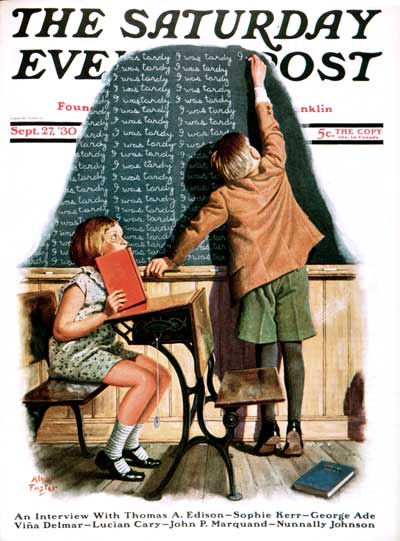
"I Was Tardy"
from September 27, 1930
Many of Foster’s nearly 30 Post covers were Rockwellian in nature: kids playing sports, or, in this example, getting in trouble in school. But there were style differences, such as the way kids are dressed. We don’t see the holes in the sweaters and patches in the knees we often see on Rockwell’s children. Props, too, seem neater. Again, what we don’t see is a well-worn broom handle or piece of broken crockery. Even the boy’s writing is perfect!
Illustrator Alan Foster passed away in 1969 at the age of 76.
Classic Covers: The Six Types of Fathers
If you think Dad has been neglected, you haven’t looked at our great collection of Saturday Evening Post covers.
Soldier and Daughter by K.R. Wireman – December 14, 1918
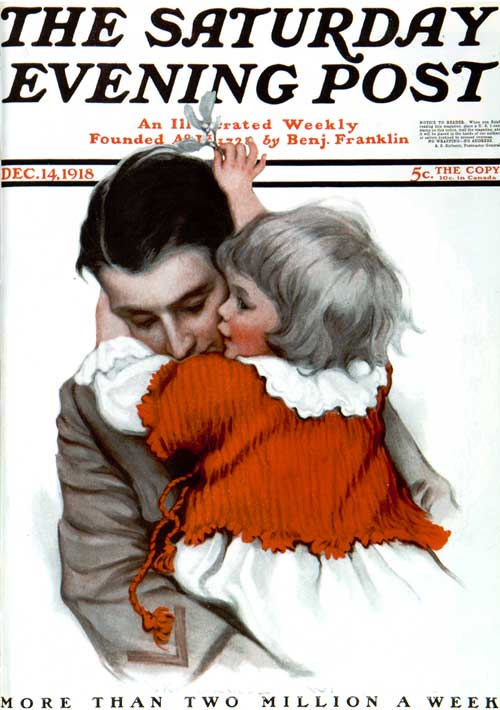
K.R. Wireman
December 14, 1918
#1 – The Grateful Dad:Dad was often a prominent feature, like this WWI soldier coming home to his daughter. It’s a rarely-seen remembrance of this era from a great artist little known today: K.R. Wireman.
Dad at Bat by Alan Foster – June 1, 1929
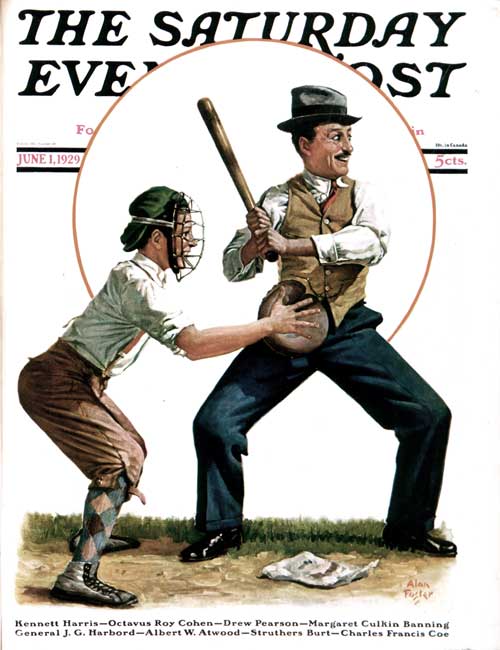
Alan Foster
June 1, 1929
#2 – The Sportsman: This is one of those covers that resembles the style of Norman Rockwell, but it was by artist Alan Foster. Dad must have just come from the office, according to his clothing, but he’s game for the game. Good batter stance, Pop.
Tea for Grandpa by C. Gager Phillips – February 18, 1933

C. Gager Phillips
February 18, 1933
#3 – The Good Sport: If tea is served in a doll-sized teacup, then by golly, dad (or granddad) will do his best to drink it. If it’s the 1930s, you can bet the little girl will have a Shirley Temple-type hairstyle. This beautiful cover is from February 1933 and was by little-known artist C. Gager Phillips.
Report Card by Frances Tipton Hunter – March 25, 1939
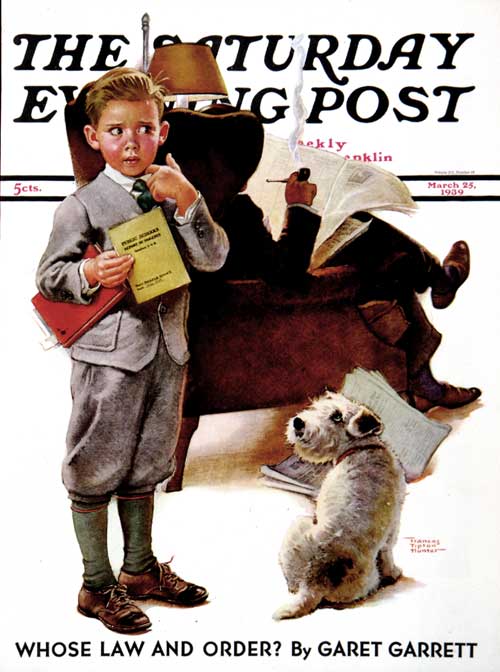
Frances Tipton Hunter
March 25, 1939
#4 – The Intimidator: If your report card was not up to snuff, you would hear about it. It’s 1939 and somebody may be about to lose his radio privileges. Even the dog is concerned. We just hope the news in the evening paper isn’t that bad. Artist Frances Tipton Hunter did a number of Post covers featuring adorable children. For more of these, go to: http://www.curtispublishing.com/artists/Hunter.shtml
Bike Riding Lesson by George Hughes – June 12, 1954
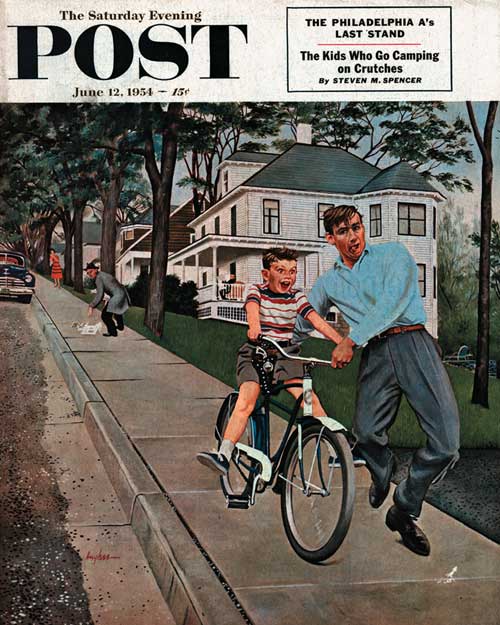
George Hughes
June 12, 1954
#5 – The Teacher: Remember all the things Dad taught you. This 1954 cover shows a kid having a great time on his bike. But Pops seems a little panicky about the stopping part. Oh, just wait, Dad. In a few years you’ll be teaching him to drive a car.
Happy Father’s Day by Howard Scott – June 19, 1943
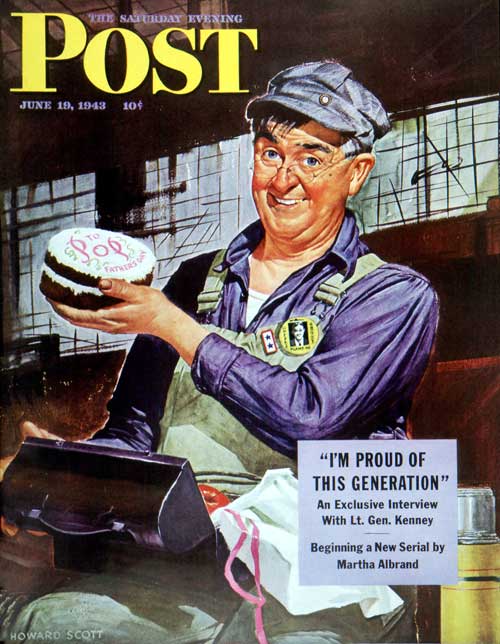
Howard Scott
June 19, 1943
#6 – The Deserving Dad: And which dad isn’t deserving of special recognition? We think getting that cake into and out of the lunchbox in perfect condition displayed a bit of artistic license, but the sentiment is spot on. If you can’t read “Pop’s” button even after clicking for a close-up, it is his ID badge to show he works at Plant 46.
Questions about a Saturday Evening Post cover? We’d love to hear from you. E-mail [email protected] or [email protected].
Classic Covers: Sled Dogs or Dogs That Sled
It’s a classic Norman Rockwell cover from 1919. The boys are careening downhill on a sled, having a great ol’ time. But look at the dog’s face. Sheer terror!
Now, we could swear it was the same dog on a 1923 Country Gentleman cover by a prominent artist named J.F. Kernan. Did Rockwell lend Kernan the dog? If so, the mutt had taken to sledding in the intervening years. This one is going for the gusto!
Really, people should ask Fido if he wants to go for a sleigh ride. On a 1930 cover by artist Alan Foster, the boy and grandpa are having a great time, but the pooch is nearly as terrified as the Rockwell dog above. We wonder if grandpa made it all the way down the hill with his still lit pipe.
Sledding by sunset are the folks on the 1948 cover by artist John Falter. Reluctant to give up a great winter’s day, the kids are still at it. And yes, one little white pooch is still sledding (in a little girl’s arms).
The snowfall is so deep on artist John Clymer’s January 1954 cover that dad is up on the roof clearing it off. Junior, on the other hand, is enjoying the white bounty, taking the dog for a sled ride. This pace a dog can handle.
Our earliest sledding cover? This beauty from November 1900. The snow created a social event, with people trudging uphill greeting sledders going downhill. And, yep, there is a pooch in the center of the action, having a ball in the snow.
George Kernan
January 13, 1923
George Gibbs
November 24, 1900
Alan Foster
February 8, 1930
John Falter
December 18, 1948
John Clymer
January 23, 1954
Norman Rockwell
December 27, 1919
Classic Covers: Are You Ready for Some Football?
What a face! Check out artist Alan Foster’s November 12, 1927, cover of the boy receiving instructions from a teammate. Judging from his expression, is he confused? Or has the teammate sent him on a suicide mission? The cover is the perfect kick off for our salute to football season.
Another terrific face appears on the November 1933 Country Gentleman cover by artist Henry Hintermeister. While the kid may be small, his concentration is intense. The dog, however, is just concentrating on the water bucket. We all have our priorities.
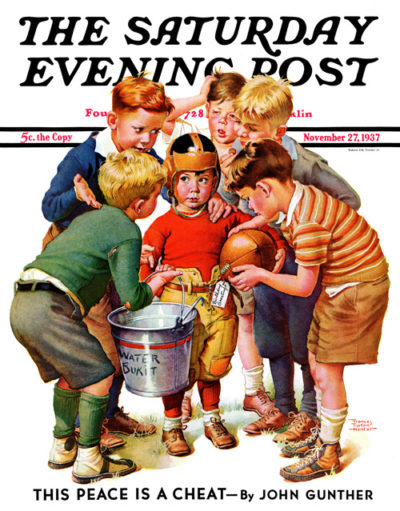
Frances Tipton Hunter
November 27, 1937
How do you become suddenly popular when you’re the smallest kid in the neighborhood? Get a brand-new football for your birthday. Artist Frances Tipton Hunter painted the cutest kids, and the November 27, 1937, cover is a picture-perfect example. The adorable tyke shifts attention away from the bigger kids, who, apparently, would like to get a game going. It appears that negotiations involve offering him the exalted position of water boy in exchange for use of the ball. Is this the same boy concentrating so intently on the game on the 1933 Country Gentleman cover mentioned earlier? Hmmm.
When did the first football cover appear on The Saturday Evening Post? Would you believe October 27, 1900? This painting of what appears to be a rousing game came from an artist who rarely scored a coveted Saturday Evening Post cover. His name remains “Unknown.”
It’s crunch time for the boys in artist Frederic Stanley’s November 1926 cover. Unfortunately, what is being crunched appears to be the boy on the bottom. Did we mention this can be a rough sport? Need further evidence? See Norman Rockwell’s November 1925 cover. Ouch! Right in the breadbasket.
Let the games begin! But may all your football memories be less painful!
Alan Foster
November 12, 1927
November 1, 1933
Frances Tipton Hunter
November 27, 1937
October 27, 1900
Frederic Stanley
November 13, 1926
Norman Rockwell
November 21, 1925
